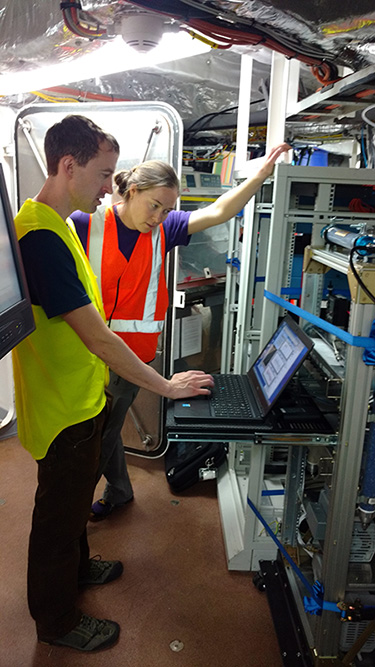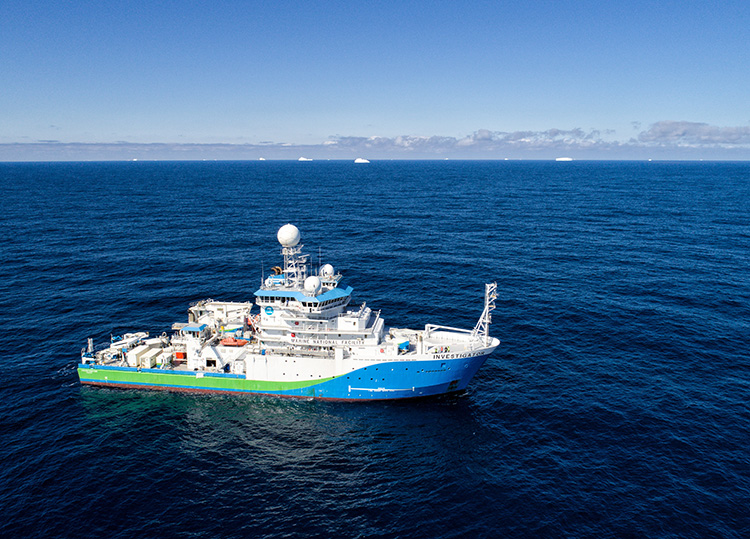ATS researchers fly and sail to stormiest place on Earth to study cloud processes
By ship and by plane, CSU Department of Atmospheric Science researchers recently ventured to the stormiest place on Earth, the Southern Ocean, to collect cloud, aerosol and precipitation data for a project known as SOCRATES. Knowledge gained during the Southern Ocean Clouds, Radiation, Aerosol Transport Experimental Study is expected to enhance weather and climate modeling and forecasting capabilities across the globe.
Graduate student Kathryn Moore, stationed aboard the research vessel (R/V) Investigator, collected data and samples to document primary ice nucleation and its influence on cloud phase. Primary ice nucleation is the formation of the first ice crystals in a cloud, which usually occurs on atmospheric aerosol particles known as ice nucleating particles, and cloud phase is the state of the cloud, liquid or ice.
“The SOCRATES project was designed to comprehensively sample and observe the interactions of aerosols with supercooled and mixed-phase clouds, to gain a better understanding of the aerosol-cloud interactions in this region, and to provide new datasets and parameterizations with which to test and improve weather and climate models,” Moore explained.
The research vessel embarked from Hobart, Tasmania on Jan. 11 and returned Feb. 22. Moore said the trip was remarkably smooth considering the region.
“There were about four to six days where waves were breaking over the bridge, six decks up, and it was too rough to get to the lab where the instruments were located. Other days varied from relatively flat, when we were close to the ice edge by Antarctica, up to six-meter swells. The Investigator has anti-roll tanks, which help reduce side-to-side motion, and I don’t suffer much from seasickness, which helps a lot when there are storms and high winds.”

Ezra Levin and Kathryn Moore test equipment aboard the R/V Investigator before it set sail Jan. 11, 2018. Photo by Paul DeMott.
Hands-on data collection was necessary to advance our understanding of cloud formation over the Southern Ocean because our current assessment is based almost entirely on satellite observations. This gap in knowledge leads to inaccurate climate models.
“The Southern Ocean is one of the most remote regions on Earth, far from anthropogenic and terrestrial aerosol sources, and so it is an ideal place to study natural aerosols and their interactions with clouds and radiation. Current weather and climate models struggle to represent this region,” Moore said.
CSU’s team of scientists had instruments aboard both the R/V Investigator, an Australian Marine National Facility research vessel, and HIAPER, or the High-performance Instrumented Airborne Platform for Environmental Research. HIAPER is a highly modified Gulfstream V jet that is owned by the National Science Foundation (NSF) and operated by the National Center for Atmospheric Research (NCAR) in Boulder. The project is a collaboration among U.S. universities and Australian scientists, with the U.S. portion funded by the NSF and supported by NCAR.
“It was truly a multinational campaign,” said senior research scientist Paul DeMott, who led the group from CSU. “Our CSU team role in general was to collect data to address an overarching hypothesis that cloud phase and lifetimes behind polar fronts in the Southern Ocean are controlled by ice nucleating particle populations unique to this region (partly due to ocean organic and biological particle emissions), with the consequence that this helps to explain errors in global climate model predictions of solar radiation reaching the ocean surface.”
Ice nucleating particles (INPs) are particles suspended in the atmosphere, which provide the foundation for the most common method of ice formation in the atmosphere. Though the INPs are very rare, they have strong control over the phase, liquid or ice, of a cloud. Once a cloud has glaciated, or turned from predominantly liquid to ice, its reflective properties and radiative effect change significantly, and it can begin to precipitate as snow or ice, rather than just rain.
DeMott shared flight scientist duties with recent CSU graduate Christina McCluskey, now an NCAR Advanced Study Program postdoctoral fellow. DeMott and McCluskey utilized two methods for assessing INP concentrations and a bioaerosol detector while flying over the Southern Ocean, just as Moore was collecting similar samples using the same methods at sea level, along with water samples.
“As expected, the concentrations of INPs over the Southern Ocean were some of the lowest on Earth, both in the marine boundary layer at the surface and higher up in the troposphere,” Moore said.
Still, the extraordinarily low numbers of INPs in the air were somewhat surprising to DeMott, as were some other discoveries.
“Clouds were also more multilayered than we anticipated, and this has implications for radiative transfer and satellite detection,” DeMott said.
Some flights had to be postponed or canceled due to unusual winds over Hobart, but DeMott said most flights were not especially turbulent.
“I only felt queasy once in the entire campaign. We primarily had to be mindful of two things – icing of the aircraft wings and instrument pods, and ingestion of too much sea salt into the engines.”
There were times the HIAPER had to climb above clouds or descend to dissipate accumulating ice. The flight crew also limited time spent at the lowest level over the ocean in high winds to avoid salt accumulation. At least once during the study, NCAR had the engines power-washed to remove salt buildup.

Cloud probes collect data on the wing of the HIAPER. Photo by Paul DeMott.
“I felt we were always safe, just a long way from home or a runway if anything had happened!” DeMott said.
Though their two months of scientific journeys by sky and by sea have come to an end, much of the work has just begun.
“Our job now is to process physical samples, analyze our own data and to integrate that with in situ data on cloud dynamics and microphysics, and remote sensing data on the same from the ships and aircraft toward answering key project science questions. It will be a massive collaborative effort,” DeMott said.
Research scientist Tom Hill and postdoctoral fellow Ezra Levin supported preparations and installations for the project, and Hill will play a major role in analyzing the collected aerosol samples.
“Some of our goals, once all the data and samples are analyzed, are to identify what the major sources of INPs in the Southern Ocean region are, characterize the biological species present through DNA analyses, and to develop a parameterization that describes INP emissions and atmospheric number concentrations that can be used in weather and climate models to improve predictions in this region,” Moore said.
Given the broad scope of the expedition and the vast amount of analysis yet to perform, discoveries and definitive conclusions are still on the horizon. However, according to DeMott, the SOCRATES project already has been a success.
“My takeaway was that we met the objective to perform the most comprehensive characterization of Southern Ocean clouds and aerosols yet undertaken, that our data sets are rich, and that we will be able to answer our major hypotheses.”
Photo at top: Australian Marine National Facility (MNF) research vessel, R/V Investigator. Photo by Kendall Sherrin (CSIRO, AU).



